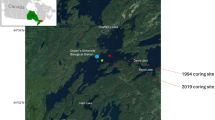Abstract
The vertical distribution of nematodes up to 20 cm sediment depth was studied over a one-year period in the alpine, oligotrophic lake Königssee. Ten water depths were examined, four of which correspond to the littoral (1 m, 2 m, 5 m, 10 m), three to the littoriprofundal (15 m, 20 m, 30 m) and three to the profundal (60 m, 120 m, 190 m). The sediment was devided into four layers (0–2 cm, 2–5 cm, 5–10 cm and 10–20 cm). (1) The highest proportion of nematodes was found in the top layer. Out of 45 263 nematodes, 89% were found in the first 5 cm of the sediment and only 1 % deeper than 10 cm. (2) The proportion of nematodes in the top layer increased along with water depth. Water depth was a better predictor of percentage of nematodes in the top layer than particle size or content of organic carbon in the sediment. (3) There were considerable differences among species in their vertical distribution in the sediment. (4) There was a significant trend for juveniles to occupy more superficial layers than adults across various species. (5) There are time related vertical preferences among adults and juveniles of several nematode species across the year, suggesting vertical migration in the sediment (e.g. Aphanolaimus aquaticus Daday, Eumonhystera longicaudatula Gerlach & Riemann, Tobrilus gracilis Bastian, Monhystera paludicola de Man, Ethmolaimus pratensis de Man and Ironus tenuicaudatus de Man). The factors determining the vertical variation in nematode abundance in freshwater systems across space and time are still unknown.
Similar content being viewed by others
References
Aller, J. Y. & R. C. Aller, 1986. Evidence for localized enhancement of biological activity associated with tube and burrow structures in deep-sea sediments at the Hebble site, western North Atlantic. Deep-Sea Res. 33: 755–790.
Blome, D., 1983. Ökologie der Nematoda eines Sandstrandes der Nordseeinsel Sylt. Mikrofauna Meeresboden 88: 1–76.
Boaden, P. J. S. & H. M. Platt, 1971. Daily migration patterns in an intertidal meiobenthic community. Thalassia Jugoslavica 7: 1–12.
Bretschko, G., 1973. Benthos production of a high-mountain lake: Nematoda. Verh. Int. Ver. Limnol. 18: 1421–1428.
Carman, K. R., K. M. Sherman & D. Thistle, 1987. Evidence that sediment type influences the horizontal and vertical distribution of nematodes at a deep-sea site. Deep-Sea Res. 34: 45–53.
Cole, G. A., 1955. An ecological study of the microbenthic fauna of two Minnesota lakes. Am. Midl. Nat. 53: 213–230.
Fenchel, T. & B. O. Jansson, 1966. On the vertical distribution of the microfauna in the sediments of a brackish-water beach. Ophelia 3: 161–177.
Fenchel, T. & R. J. Riedl, 1970. The sulfide system: a new biotic community underneath the oxidized layer of marine sand bottoms. Mar. Biol. 7: 255–268.
Joint, J. R., J. M. Gee & R. M. Warwick, 1982. Determinations of finescale vertical distribution of microbes and meiofauna in an intertidal sediment. Mar. Biol. 72: 157–164.
Moore, G. M., 1939. A limnological investigation of the microscopic benthic fauna of Douglas Lake, Michigan. Ecol. Monogr. 9: 537–582.
Morrill, A. C., E. N. Powell, R. R. Bidigare & J. M. Shick, 1988. Adaptations to life in the sulfide system: a comparison of oxygen detoxifying enzymes in thiobiotic and oxybiotic meiofauna (and freshwater planarians). J. Comp. Physiol. B. 158: 335–344.
Pfannkuche, 0., 1985. The deep-sea meiofauna of the Porcupine Seabight and abyssal plain (NE Atlantic): population structure, distribution, standing stocks. Oceanol. Acta 8: 343–353.
Platt, H. M., 1977. Vertical and horizontal distribution of free-living marine nematodes from Strangford Lough, Northern Ireland. Cah. Biol. Mar. 18: 261–273.
Reise, K. & P. Ax, 1979. A meiofaunal ‘thiobios’ limited to the anaerobic sulfide system of marine sand does not exist. Mar. Biol. 54: 225–237.
Schiemer, F., H. Loffler & H. Dollfuss, 1969. The benthic communities of Neusiedlersee (Austria). Verh. int. Ver. theor. angew. Limnol. 17: 201–208.
Seinhorst, W., 1959. A rapid method for the transfer of nematodes from fixative to anhydrous glycerin. Nematologica 4: 67–69.
Seinhorst, W., 1962. On the killing, fixation and transferring to glycerin of nematodes. Nematologica 8: 29–32.
Siebeck, O., 1985. Der Königssee. Eine limnologische Projektstudie. Forsch. Ber. 5/1982, 2nd ed., Nationalparkverwaltung Berchtesgaden, Berchtesgaden, 131 pp.
Stanczykowska, A., 1966. Some methodical problems in zoomicrobenthos studies. Ekol. Pol. 14: 385–393.
Tietjen, J. H., 1977. Population distribution and structure of the freeliving nematodes of Long Island Sound. Mar. Biol. 43: 123–136.
Tietjen, J. H., J. W. Deming, G. T. Rowe, S. Macko & R. J. Wilke, 1989. Meiobenthos of the Hatteras Abyssal Plain and Puerto Rico Trench: abundance, biomass and associations with bacteria and particulate fluxes. Deep-Sea Res. 36: 1567–1577.
Traunspurger, W., 1991. Fischbiologie des Königssees. Nahrungsangebot und Nahrungswahl. Band 1. Forsch. Ber. 22, Nationalpark Berchtesgaden, Berchtesgaden, 152 pp.
Traunspurger, W., 1996a. Distribution of benthic nematodes in the littoral of an oligotrophic lake (Königssee, National Park Berchtesgaden, FRG). Arch. Hydrobiol. 135: 393–412.
Traunspurger, W., 1996b. Distribution of benthic nematodes in the littoriprofundal and profundal of an oligotrophic lake (Königssee, National Park Berchtesgaden, FRG). Arch. Hydrobiol. 135: 557–575.
Uhlig, G., H. Thiel & J. S. Gray, 1973. The quantitative separation of meiofauna. Helgolander wiss. Meeresunters. 25: 173–195.
Vanreusel, A., M. Vincx, D. Schram & D. Van Gansbeke, 1995. On the vertical distribution of the metazoan meiofauna in shelf break and upper slope habitats of the NE Atlantic. Int. Revue ges. Hydrobiol. 80: 313–326.
Wieser, W., 1975. The meiofauna as a tool in the study of habitat heterogeneity: Ecophysiological aspects. A review. Cah. Biol. Mar. 16: 647–670.
Wieser, W. & J. Kanwisher, 1961. Ecological and physiological studies on marine nematodes from a small salt marsh near Woods Hole, Massachusetts. Limnol. Oceanogr. 6: 262–270.
Author information
Authors and Affiliations
Rights and permissions
About this article
Cite this article
Traunspurger, W., Drews, C. Vertical distribution of benthic nematodes in an oligotrophic lake: seasonality, species and age segregation. Hydrobiologia 331, 33–42 (1996). https://doi.org/10.1007/BF00025405
Received:
Revised:
Accepted:
Issue Date:
DOI: https://doi.org/10.1007/BF00025405




